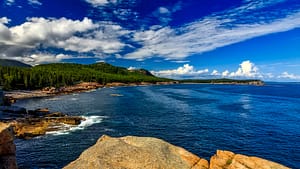Maine has a long history of inhabitation by Native American tribes such as the Algonquian-speaking Penobscot, Wabanaki, Abenaki, and Maliseet. Their legacy remains only in town names and a handful of historic sites as nearly all were routed north to Canada by the 18th century.
The French were the first Europeans to settle in Maine on St Croix Island in 1604. The famous French explorer Samuel de Champlain named the region Acadia, which extended well into modern-day Canada. In 1607, the first English settlement appeared farther south at Popham, though this village was abandoned a year later. Another attempt by the English to take over the area was made in 1623 near York, but it too failed.
The French Jesuit missionaries built on Penobscot Bay in 1609 and Mount Desert Island in 1613. As France lost its hold over the region, Maine became part of the Massachusetts Bay Colony in 1652. The French, English, and their native allies fought fiercely over the border territory throughout the 17th and 18th centuries. It wasn’t until the American Revolution and the War of 1812 that the US finally gained full control of Maine, with the present-day border established in 1842.
Maine became the 23rd state of America in 1820 and named its first capital Portland. In 1832, the capital was moved to Augusta for a more centralized location. Industrialization in the state was focused primarily on timber harvesting, ship building, and cotton mills. Fishing and stone quarries were also important parts of the early economy. Later, the timber sector evolved into pulp and paper, and much of the North Woods is still owned by paper companies today.
Maine was the first state in New England to support the Union’s bid for an anti-slavery nation. Abraham Lincoln chose a Maine native to be his Vice-President and the state played a key role in helping the north win the Civil War. In modern times, Maine has largely kept to itself as a timber and agricultural region. Wealthy families from the east coast began using the area as their summer getaways in the late 19th century, a tradition that continues today in coastal villages like Kennebunkport.
Maine is an interesting place; it’s part of New England, but somehow feels very different than Vermont and New Hampshire. This is largely due to its location at the far north of the country and its historic ties with French Acadia. There is an unusual ethnic mix at work here, with a large number of Irish, Scottish, and French-Canadians in the population.
As early as the mid-1800’s, Maine began to be touted as the greatest summer vacation destination in America. Summer resort towns like Bar Harbor, Islesboro, and Sorrento were born along the coast to provide an escape for the wealthy of the east coast’s big cities. This image is largely a myth, however, because Maine has always been one of the poorest states in the area. The creation of state parks like Acadia and the continued promotion of its coastal towns have made tourism a major economic factor.

